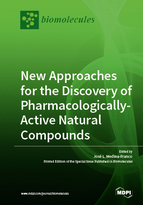New Approaches for the Discovery of Pharmacologically-Active Natural Compounds
A special issue of Biomolecules (ISSN 2218-273X).
Deadline for manuscript submissions: closed (1 December 2018) | Viewed by 57807
Special Issue Editor
Interests: drug discovery; computational medicinal chemistry; chemoinformatics; molecular modeling; epigenetics; natural products; food chemicals
Special Issues, Collections and Topics in MDPI journals
Special Issue Information
Dear Colleagues,
Natural products continue to be a major source of active compounds. Natural products from different sources have provided large number of molecules approved for clinical use or that have been used as starting points of optimization programs. Similarly, natural products have inspired the synthesis and development of biologically active molecules. However, identifying pharmacologically active natural products in an efficient and systematic manner is challenging. To this end, a broad range of experimental and computational approaches have evolved in recent years, boosted by the progress on technological advances of screening strategies. In many cases both experimental and theoretical methods are used in synergy. The goal of this Special Issue is to present recent progress on technological advances and applications of different approaches to identify pharmacologically active natural products.
We invite scientists doing research on this area to submit their original research (as full papers or short communications) and review papers for publication in this Special Issue. Topics of interest include, but are not limited to, metabolomics, high content screening, phenotypic screening, bioprospection of natural products, reverse pharmacognosy, data mining, virtual screening, molecular modelling, and artificial intelligence. Experimental and theoretical research studies are welcome. Multi-disciplinary approaches are encouraged.
I look forward your contributions.
Dr. José L. Medina-Franco
Guest Editor
Manuscript Submission Information
Manuscripts should be submitted online at www.mdpi.com by registering and logging in to this website. Once you are registered, click here to go to the submission form. Manuscripts can be submitted until the deadline. All submissions that pass pre-check are peer-reviewed. Accepted papers will be published continuously in the journal (as soon as accepted) and will be listed together on the special issue website. Research articles, review articles as well as short communications are invited. For planned papers, a title and short abstract (about 100 words) can be sent to the Editorial Office for announcement on this website.
Submitted manuscripts should not have been published previously, nor be under consideration for publication elsewhere (except conference proceedings papers). All manuscripts are thoroughly refereed through a single-blind peer-review process. A guide for authors and other relevant information for submission of manuscripts is available on the Instructions for Authors page. Biomolecules is an international peer-reviewed open access monthly journal published by MDPI.
Please visit the Instructions for Authors page before submitting a manuscript. The Article Processing Charge (APC) for publication in this open access journal is 2700 CHF (Swiss Francs). Submitted papers should be well formatted and use good English. Authors may use MDPI's English editing service prior to publication or during author revisions.
Keywords
- metabolomics
- high content screening
- phenotypic screening
- bioprospection of natural products
- reverse pharmacognosy
- data mining
- virtual screening
- molecular modelling
- artificial intelligence







